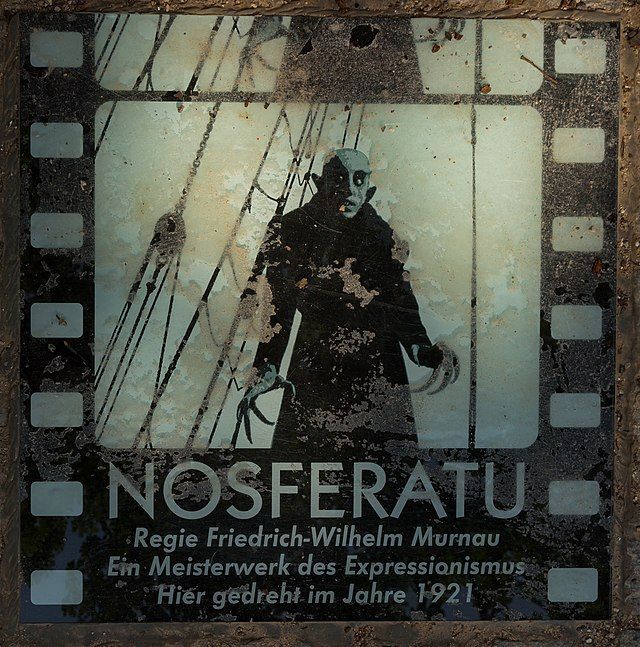F.W. Murnau’s haunting film Nosferatu (1922) and Count Orlock, its vampire, turn 100 years old this month. The title villain brought plague from one country to another. The movie brought a new type of fear to a world that almost didn’t see it.
For Nosferatu, Murnau adapted Bram Stoker’s 1897 novel Dracula, but he didn’t obtain copyright permission. A court ordered all prints of the plagiarized Nosferatu to be destroyed. They weren’t, thankfully, with Nosferatu slowly infecting the globe, traversing much further than Count Orlock does in the film.
At its centenary, Nosferatu is now much more than a movie. It has become an icon, even a brand. If 7 Up is the Uncola, Nosferatu is definitely the unDracula. However much Murnau relied on Stoker, Nosferatu became something very different.
In the film, Orlock is a pestilence, he and the rats that travel with him, which results in a dark parade of coffins. “Close all doors and windows!” one politician orders. Those who are ill in the “fear-stricken” town must stay at home. Some of them stupidly refuse to do so.
It’s worth remembering that Murnau directed the film shortly after the Great Influenza pandemic of 1918 that took millions of lives.
Though unknown even to most film historians, Nosferatu premiered not in Germany but in Rotterdam, opening day February 17, 1922. The first advertisement described the vampire as the origin of the plague. And the first review warned audiences, “disgust becomes horror when one sees his strange appearance.” Orlock represented more than one type of contagion.
From Holland, Nosferatu spread to Berlin, Paris, London, and other countries, first showing up in America in 1924 and then again later in the decade. In 1929, a critic for The New York Times condemned the movie for being “not especially stirring.” At that time, the comment might have been fair, given that it would have seemed old-fashioned next to the new talking pictures. The critic even noticed a fellow audience member dozing audibly.
When Nosferatu was reissued in modified form in 1930 as The Twelfth Hour, its new title signaled what could well have become its fate, the chimes at midnight being tolled. After all, most films do sink into obscurity.
Thankfully Murnau’s reputation kept Nosferatu alive, undead, still sinking its teeth into us. Orlock became better known during the fifties and sixties than ever before. Photographs of the vampire appeared in film studies books and monster fanzines.
But Nosferatu had yet not clawed its way into popular culture. An advertising agency recreated Orlock’s unmistakable shadow for a 1980 Pils Beer TV commercial. Advertising Age mistook the image for being a “hag” instead of a vampire.
Elsewhere, various artists were undertaking tributes to the film. Blue Öyster Cult gave us less cowbell and more vampire in their 1977 song Nosferatu. (“Rats in the hold, My crew is dead, I fear the plague.”)
Werner Herzog remade the film with Klaus Kinski. Nosferatu the Vampyre (1979) not only played theaters globally, but also resulted in a book-of-the-movie. “The curse will weigh heavily on the people,” one of the movie characters declares. In the book, a baby is even born with the head of a rat.
That same year, the vampire in the classic TV mini-series Salem’s Lot (1979) didn’t look like Stoker’s Dracula, or Bela Lugosi’s. He was Nosferatu reborn.
From there, Count Orlock kept infecting our dreams and nightmares. The Gothic rock band Nosferatu formed in the late eighties. And in The Vampire’s Kiss (1989), Nicolas Cage’s would-be undead character watches Orlock on TV to get cues on how to behave. Apparently we can learn a lot from horror and the plague.
During the nineties, we saw Nosferatu as a musical, as a comic book, and as a character on SpongeBob SquarePants. And then of course there was Shadow of the Vampire (2000), E. Elias Merhige’s fantastical alternate history of Nosferatu’s production that starred John Malkovich and Willem Dafoe.
Count Orlock’s bloody pyramid scheme has increased its brand one hundred-fold. No one mistakes this vampire for a hag anymore. He’s more famous than ever before. Think “Stanferatu” on a 2019 episode of American Dad.
As for 2022, Orlock will bite us again and again, in the form of Simon Bacon’s new book about the film, as well as action figures, T-shirts, model kits, and more.
What we won’t be doing is visiting Nosferatu’s shooting locations in Germany and Slovakia, even though that trip has become a favorite tour for many film buffs, including myself.
Covid-19 requires the scourge of Count Orlock to come to us, rather than the other way around. So be it. Nosferatu outlasted attempts to kill it. So shall we when it comes to coronavirus. The vampire endures. The plague dissipates.
¤
Gary D. Rhodes, Ph.D. is the author of several books on horror and vampire films, and is cohost of the international conference Horror Reverie, which will remotely celebrate Nosferatu's centenary on February 19, 2022.
LARB Contributor
Gary D. Rhodes, Ph.D., is the author of over 20 books on the cinema, among them The Perils of Moviegoing in America, The Birth of the American Horror Film, and (with Robert Singer) Consuming Images: Film Art and the American Television Commercial. He is also the writer-director of various films, including Banned in Oklahoma and Lugosi: Hollywood's Dracula. Rhodes serves as an associate professor of Film and Mass Media at the University of Central Florida.
Did you know LARB is a reader-supported nonprofit?
LARB publishes daily without a paywall as part of our mission to make rigorous, incisive, and engaging writing on every aspect of literature, culture, and the arts freely accessible to the public. Help us continue this work with your tax-deductible donation today!
